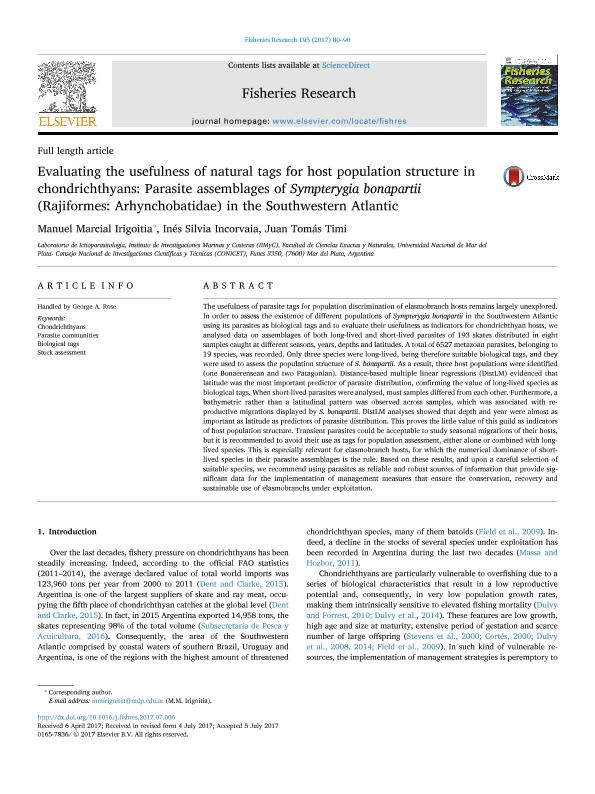Artículo
Evaluating the usefulness of natural tags for host population structure in chondrichthyans: parasite assemblages of Sympterygia bonapartii (Rajiformes: Arhynchobatidae) in the Southwestern Atlantic
Fecha de publicación:
11/2017
Editorial:
Elsevier Science
Revista:
Fisheries Research
ISSN:
0165-7836
e-ISSN:
1872-6763
Idioma:
Inglés
Tipo de recurso:
Artículo publicado
Clasificación temática:
Resumen
The usefulness of parasite tags for population discrimination of elasmobranch hosts remains largely unexplored. In order to assess the existence of different populations of Sympterygia bonapartii in the Southwestern Atlantic using its parasites as biological tags and to evaluate their usefulness as indicators for chondrichthyan hosts, we analysed data on assemblages of both long-lived and short-lived parasites of 193 skates distributed in eight samples caught at different seasons, years, depths and latitudes. A total of 6527 metazoan parasites, belonging to 19 species, was recorded. Only three species were long-lived, being therefore suitable biological tags, and they were used to assess the population structure of S. bonapartii. As a result, three host populations were identified (one Bonaerensean and two Patagonian). Distance-based multiple linear regressions (DistLM) evidenced that latitude was the most important predictor of parasite distribution, confirming the value of long-lived species as biological tags. When short-lived parasites were analysed, most samples differed from each other. Furthermore, a bathymetric rather than a latitudinal pattern was observed across samples, which was associated with reproductive migrations displayed by S. bonapartii. DistLM analyses showed that depth and year were almost as important as latitude as predictors of parasite distribution. This proves the little value of this guild as indicators of host population structure. Transient parasites could be acceptable to study seasonal migrations of their hosts, but it is recommended to avoid their use as tags for population assessment, either alone or combined with long-lived species. This is especially relevant for elasmobranch hosts, for which the numerical dominance of short-lived species in their parasite assemblages is the rule. Based on these results, and upon a careful selection of suitable species, we recommend using parasites as reliable and robust sources of information that provide significant data for the implementation of management measures that ensure the conservation, recovery and sustainable use of elasmobranchs under exploitation.
Palabras clave:
Biological Tags
,
Chondrichthyans
,
Parasite Communities
,
Stock Assessment
Archivos asociados
Licencia
Identificadores
Colecciones
Articulos(IIMYC)
Articulos de INSTITUTO DE INVESTIGACIONES MARINAS Y COSTERAS
Articulos de INSTITUTO DE INVESTIGACIONES MARINAS Y COSTERAS
Citación
Irigoitia, Manuel Marcial; Incorvaia, Inés Silvia; Timi, Juan Tomas; Evaluating the usefulness of natural tags for host population structure in chondrichthyans: parasite assemblages of Sympterygia bonapartii (Rajiformes: Arhynchobatidae) in the Southwestern Atlantic; Elsevier Science; Fisheries Research; 195; 11-2017; 80-90
Compartir
Altmétricas




